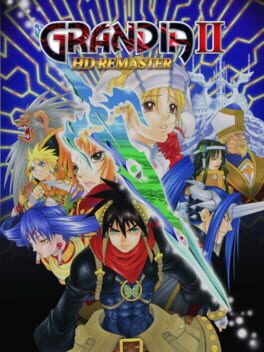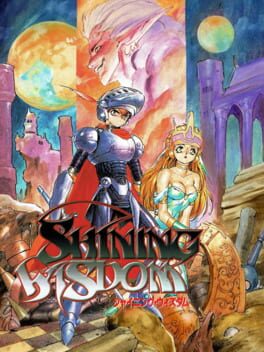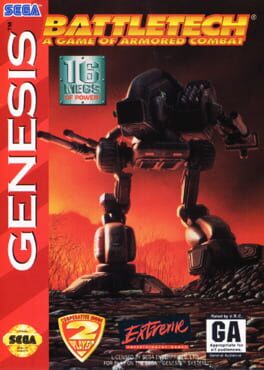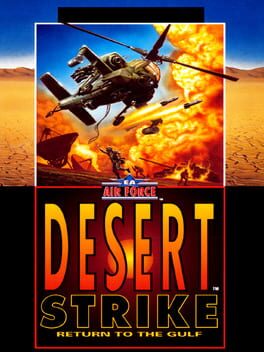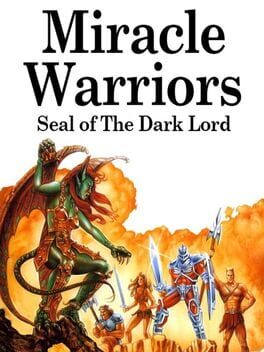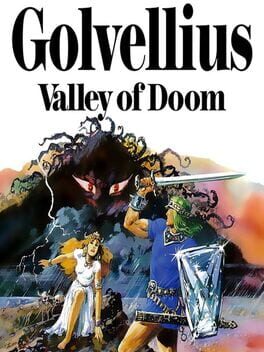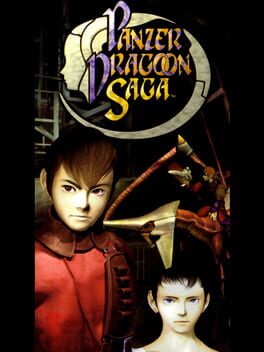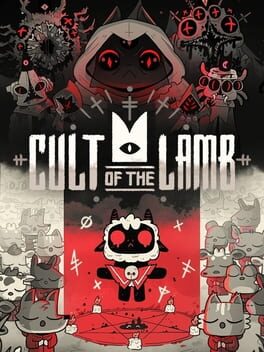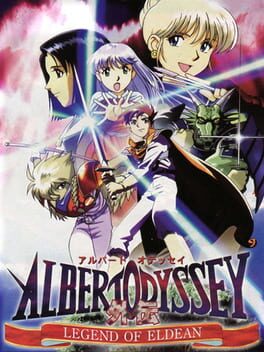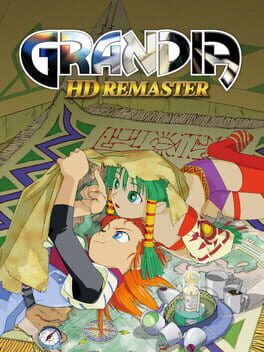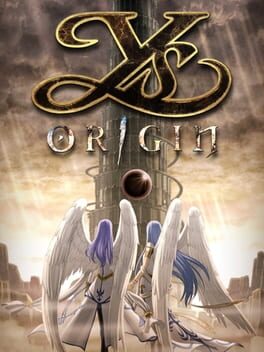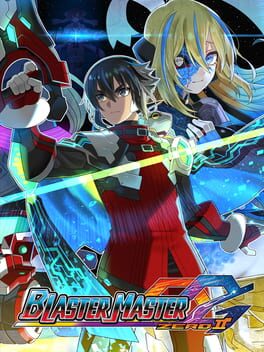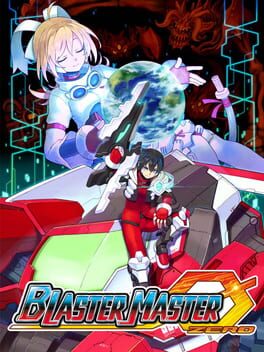GhaleonEB
BACKER
Grandia II is a good example of how to make a sequel without repeating the original game. The setting, story and characters are quite different from the first Grandia, but the spirit is there, along with the superb battle system.
Grandia II again takes what might be a familiar setting, and takes it in unexpected and creative directions. We have yet another world living in the aftermath of a battle between two gods, their struggle faded to legend. Shockingly, an organization is working to revive one of them and destroy the world.
Against a familiar premise, we get extraordinary characters. The lead character, Ryudo, is such a mercenary and a jerk that I actually did not like him for a good chunk of the game, which is not great if you want to put yourself in their shoes. But the purpose of his characterization becomes clear as the story unfolds and his world view is challenged and his history emerges. There's actual character growth and in the end Ryudo had won me over as the reluctant hero doing what must be done.
And then there's Millenia and Elena, who have a decidedly, um, strange relationship. And once again, we get an initially unlikable character in Millenia who experiences significant character development, and is one of the most compelling antiheroes I've seen in an RPG.
The battle system is as great as the first Grandia, constantly engaging even during easy battles. There's something very satisfying about successfully anticipating enemy attacks and staging responses and counters just in time; watching a strategic plan unfold is constantly rewarding.
I didn't find the overall world as compelling or as inventively weird as the first Grandia. Much of the game felt more conventional and familiar, while Grandia's world was constantly surprising. But the story quite masterfully follows the first games gradual escalation from boots on the ground struggle to world-ending danger, so slowly and smoothly that it's never jarring. The scale of some of the battles and story beats in the third act were breathtaking.
I played on the Switch Grandia I & II HD remaster physical release, and once again I was reminded that this is a low effort remaster with muddy, smeared visuals. Fortunately I'll have the option of playing the original release on the Dreamcast soon. I played this on the hard setting, which addressed my lone major critique of the first game with its easy difficulty. I'll probably miss that with the DC release.
Even with the flawed remaster, I'm glad I got to experience this game, and I'm already looking forward to spending more time with these characters and exploring their world and story again. It's a shame the series did not continue, but we got two highly original, compelling stories from them and a huge cast of memorable characters. It's hard to ask for more from an RPG.
Grandia II again takes what might be a familiar setting, and takes it in unexpected and creative directions. We have yet another world living in the aftermath of a battle between two gods, their struggle faded to legend. Shockingly, an organization is working to revive one of them and destroy the world.
Against a familiar premise, we get extraordinary characters. The lead character, Ryudo, is such a mercenary and a jerk that I actually did not like him for a good chunk of the game, which is not great if you want to put yourself in their shoes. But the purpose of his characterization becomes clear as the story unfolds and his world view is challenged and his history emerges. There's actual character growth and in the end Ryudo had won me over as the reluctant hero doing what must be done.
And then there's Millenia and Elena, who have a decidedly, um, strange relationship. And once again, we get an initially unlikable character in Millenia who experiences significant character development, and is one of the most compelling antiheroes I've seen in an RPG.
The battle system is as great as the first Grandia, constantly engaging even during easy battles. There's something very satisfying about successfully anticipating enemy attacks and staging responses and counters just in time; watching a strategic plan unfold is constantly rewarding.
I didn't find the overall world as compelling or as inventively weird as the first Grandia. Much of the game felt more conventional and familiar, while Grandia's world was constantly surprising. But the story quite masterfully follows the first games gradual escalation from boots on the ground struggle to world-ending danger, so slowly and smoothly that it's never jarring. The scale of some of the battles and story beats in the third act were breathtaking.
I played on the Switch Grandia I & II HD remaster physical release, and once again I was reminded that this is a low effort remaster with muddy, smeared visuals. Fortunately I'll have the option of playing the original release on the Dreamcast soon. I played this on the hard setting, which addressed my lone major critique of the first game with its easy difficulty. I'll probably miss that with the DC release.
Even with the flawed remaster, I'm glad I got to experience this game, and I'm already looking forward to spending more time with these characters and exploring their world and story again. It's a shame the series did not continue, but we got two highly original, compelling stories from them and a huge cast of memorable characters. It's hard to ask for more from an RPG.
Quackshot is one of those rare games that is fun immediately, and stays that way right through to the end with no missteps along the way. An action platformer starring Donald Duck in full Ducktails / Indiana Jones mode. It packs an enormous amount of variety into it's hour long playtime.
The structure is creative: instead of a series of stages you play linearly, every level is broken into parts, and you can usually only play the first one up to a point before hitting an obstacle. The key to getting past that obstacle is located in another stage, and you can pick from one of several stages to play at any point in time, up until the the final two. This means we're constantly playing short, highly varied levels and hopping around between different environments with the option of several different orders to play through. Nothing ever wears out its welcome and the option to tackle stages in different orders made replaying the game feel fresh.
Donald's signature attack is a plunger gun, which stuns but does not kill enemies. This factors into the core gameplay loop, as you need to progress past stunned enemies lest they revive and resume attacking. So while there is no timer running on any stage, there is some pressure to keep moving. Early in the game the plungers start sticking to walls and forming temporary platforms, and that's when the game goes from good to great. Most stages require clever use of the plunger to scale surfaces, find secrets and work around danger. The controls are superb and it just feels great to jump, fire a shot into the wall, and then land on it.
Levels can be simple side scrolling platforming affairs, or involve lots of vertical climbing. Some stages feature fast segments on ziplines or carts, while others require slow navigation through traps and obstacles. There's even a maze thrown into the mix to overcome. It's a testament to how well designed Quackshot is that every type of stage is fun - there's not a bummer of a stage among them.
Quackshot is features gorgeous artwork, very colorful and is well animated. It's also not especially difficult, some rather trickly platforming near the end aside. That could be seen as a major downside, but I found the whole game to be very well balanced. It's seldom straight up easy, as platforming failures usually result in instant death and several areas require great focus and precision. But for most experienced players, it's an easy clear.
And that's okay. The intended audience here was not hardcore gamers, it's Donald Duck game. This is a highly accessible, enormously entertaining romp with a great deal of variety. There are no technical issues, it's constantly very pretty and the soundtrack is great throughout. My only quibble is I'd like to have had it be a bit longer, and with a password system so I could have rested my old hands during a playthrough. Otherwise, this is pretty much a perfect bite-sized action game.
The structure is creative: instead of a series of stages you play linearly, every level is broken into parts, and you can usually only play the first one up to a point before hitting an obstacle. The key to getting past that obstacle is located in another stage, and you can pick from one of several stages to play at any point in time, up until the the final two. This means we're constantly playing short, highly varied levels and hopping around between different environments with the option of several different orders to play through. Nothing ever wears out its welcome and the option to tackle stages in different orders made replaying the game feel fresh.
Donald's signature attack is a plunger gun, which stuns but does not kill enemies. This factors into the core gameplay loop, as you need to progress past stunned enemies lest they revive and resume attacking. So while there is no timer running on any stage, there is some pressure to keep moving. Early in the game the plungers start sticking to walls and forming temporary platforms, and that's when the game goes from good to great. Most stages require clever use of the plunger to scale surfaces, find secrets and work around danger. The controls are superb and it just feels great to jump, fire a shot into the wall, and then land on it.
Levels can be simple side scrolling platforming affairs, or involve lots of vertical climbing. Some stages feature fast segments on ziplines or carts, while others require slow navigation through traps and obstacles. There's even a maze thrown into the mix to overcome. It's a testament to how well designed Quackshot is that every type of stage is fun - there's not a bummer of a stage among them.
Quackshot is features gorgeous artwork, very colorful and is well animated. It's also not especially difficult, some rather trickly platforming near the end aside. That could be seen as a major downside, but I found the whole game to be very well balanced. It's seldom straight up easy, as platforming failures usually result in instant death and several areas require great focus and precision. But for most experienced players, it's an easy clear.
And that's okay. The intended audience here was not hardcore gamers, it's Donald Duck game. This is a highly accessible, enormously entertaining romp with a great deal of variety. There are no technical issues, it's constantly very pretty and the soundtrack is great throughout. My only quibble is I'd like to have had it be a bit longer, and with a password system so I could have rested my old hands during a playthrough. Otherwise, this is pretty much a perfect bite-sized action game.
1995
The Shining series having spanned first-person dungeon and strategy RPGs, Shining Wisdom moved onto Zelda-like territory, with much less success than the prior genre entries. The world design, dungeons and story are all excellent and it was a lot of fun to aquire abilities and then re-explore areas for new secrets, which is frequently rewarded, and some of the secret areas or minigames are pretty substantial. The score is also excellent.
The failings here are largely in the controls and artwork. Character models are 2D sprites of 3D renderings of that mid-90''s style during the transition to 32-bit systems, and it's not pretty. Worse are controls that are a bit muddy, and catastrophic is the decision to require power moves charge up by hammering the power button to fill a meter as opposed to just...holding it down? Very strange.
Still, for me the great world and dungeon designs push this into 'fun but flawed' territory. Wisdom is probably the black sheep of the OG Shining series, but it's still not a bad game.
The failings here are largely in the controls and artwork. Character models are 2D sprites of 3D renderings of that mid-90''s style during the transition to 32-bit systems, and it's not pretty. Worse are controls that are a bit muddy, and catastrophic is the decision to require power moves charge up by hammering the power button to fill a meter as opposed to just...holding it down? Very strange.
Still, for me the great world and dungeon designs push this into 'fun but flawed' territory. Wisdom is probably the black sheep of the OG Shining series, but it's still not a bad game.
1992
The Humans is a puzzle/platformer, a genre I'd not played before. It's a better puzzle game than a platform or action game, as some of the mechanics can be clunky a times. A few stages push the action or platforming elements to the point where the rough edges come to the foreground. But those handful of issues aside, even stage is incredibly well designed and were fun to crack. And many of them had multiple solutions, including some enormous shortcuts. (It's not entirely clear to me if all of them were intentional, but the stages are so well thought out that I suspect most of them are).
The main flaw is in the lack of variety: all the ideas are on the table by around level 35 or so, after which the game iterates. Against this flaw is a lot of creativity, and very smart pacing. Right up through the end, the long and complex levels are followed by several bite-sized ones. This gives the game a cadence to the challenge, rather than having escalating complexity and challenge that could turn the endgame into a slog. Really smart game design.
There's also the issue of audio: on the Genesis, I could play with music or sound effects - but not both. Selecting one turns the other off. It's not as if either is pushing the Genesis hardware, so I suspect this a result of a rushed port from developers not familiar with the hardware. I played with sound effects instead of music as I found I needed the feedback that came from selecting and completing actions.
This genre of level-based action/puzzle games is new to me and I had a lot of fun with it. With a touch more variety and better audio it would have been better, but for the content they had, it's an incredibly well designed game, especially given the small team per the credits.
The main flaw is in the lack of variety: all the ideas are on the table by around level 35 or so, after which the game iterates. Against this flaw is a lot of creativity, and very smart pacing. Right up through the end, the long and complex levels are followed by several bite-sized ones. This gives the game a cadence to the challenge, rather than having escalating complexity and challenge that could turn the endgame into a slog. Really smart game design.
There's also the issue of audio: on the Genesis, I could play with music or sound effects - but not both. Selecting one turns the other off. It's not as if either is pushing the Genesis hardware, so I suspect this a result of a rushed port from developers not familiar with the hardware. I played with sound effects instead of music as I found I needed the feedback that came from selecting and completing actions.
This genre of level-based action/puzzle games is new to me and I had a lot of fun with it. With a touch more variety and better audio it would have been better, but for the content they had, it's an incredibly well designed game, especially given the small team per the credits.
Ostensibly a top-down action game, success in Battletech rests not with reflexes or aim but with strategy and tactics. I'm not sure what to call this genre, so I'm going with the highly original "strategic action", which would include games such as Desert Strike. Battletech has some strong similarities in design to that game: we're not especially agile, are loaded with powerful weapons that are none the less in short supply, and we're a glass cannon; the health meter seems generous until you step into a crossfire or wander carelessly into a minefield and then you're toast in seconds.
Battletech is hard. Very, very hard. After the first mission, which is essentially a (still hard) tutorial, my first impression of every subsequent new planet was that the next mission was impossible. I would get annihilated in minutes. Environmental hazards such as fire, ice and spikes (or better yet, ice that causes you to slide into spikes) are devastating and small mishaps can torpedo a run.
But then I'd start to learn the level layout, remembering where the ammo caches were and the crucial health restoring coolant, which formed a checkpoint of sorts. If I could just get to that first coolant drop without dying, I could extend the run. Then I'd manage it, and inch ever so much further into the mission. Learning enemy locations, avoiding crossfires and traps, and plotting an optimal route through the increasingly enormous levels, crisscrossing to ammo and health pickups just in time. These are the keys to success, and each mission slowly reveals itself to be masterfully designed and well balanced. The final one in particular is an enormous, wide-open gauntlet that leaves it entirely up to us to explore and figure out.
I'd be remiss not to mention the audio: the voice samples are very good! The sound effects are awful, sounding like the worst that the GEMS studio had to offer, and the little music on hand (only playing before and after missions) is flat and lifeless. It's games like Battletech that unfairly maligned the reputation of the Genesis sound chip.
But other than the disappointing audio? Battletech is awesome.
Battletech is hard. Very, very hard. After the first mission, which is essentially a (still hard) tutorial, my first impression of every subsequent new planet was that the next mission was impossible. I would get annihilated in minutes. Environmental hazards such as fire, ice and spikes (or better yet, ice that causes you to slide into spikes) are devastating and small mishaps can torpedo a run.
But then I'd start to learn the level layout, remembering where the ammo caches were and the crucial health restoring coolant, which formed a checkpoint of sorts. If I could just get to that first coolant drop without dying, I could extend the run. Then I'd manage it, and inch ever so much further into the mission. Learning enemy locations, avoiding crossfires and traps, and plotting an optimal route through the increasingly enormous levels, crisscrossing to ammo and health pickups just in time. These are the keys to success, and each mission slowly reveals itself to be masterfully designed and well balanced. The final one in particular is an enormous, wide-open gauntlet that leaves it entirely up to us to explore and figure out.
I'd be remiss not to mention the audio: the voice samples are very good! The sound effects are awful, sounding like the worst that the GEMS studio had to offer, and the little music on hand (only playing before and after missions) is flat and lifeless. It's games like Battletech that unfairly maligned the reputation of the Genesis sound chip.
But other than the disappointing audio? Battletech is awesome.
I went into Desert Strike thinking it was a fast, top-down shoot'em up. It's actually a methodically paced, highly strategic action game with a large emphasis on exploration and resource management. Taken on its own terms, it's a brilliantly designed game.
There are four campaigns, each set on large wide open maps filled with enemies, buildings, missions and, critically, resources. While the missions are listed in order in the pause menu, along with the map and a wealth of other info, most can be completed in any order. It was a lot of fun learning what the objectives were and finding optimal ways to complete them.
Exploration, resource management and careful approach of enemy strongpoints are the keys to the game. While there is no time limit, there is an urgency due to the fuel gauge constantly going down, replenished by fuel drums dotted around the map. Some are placed in the open, some have to be found by demolishing structures or vehicles. Likewise the crucial ammunition crates. Civilians and POWs serve as armor restoration when picked up and rescued, and it's this juggling of armor, ammo and fuel management between strike runs that will form the main gameplay loop.
The actual combat takes some getting used to: the chopper is fragile and can be downed in seconds if you take a head-on approach to enemy tanks or AA weapons. You have to take care to peel off enemy locations from the outside in, not get surrounded and always be moving. Even so, death comes fast and often early in the learning curve. The game is hard, but as you explore each map you'll find ample resources to balance out the challenge. The game offers several control settings, and as I understand it some of them play easier than the default "with momentum", but I used the default, adjusted, and enjoyed it.
The most unfortunate decision in the game design was to omit any HUD elements whatsoever. This gives the game a very nice clean look, but you have to pause to see your ammo counts and fuel meters, which often led me to run out of ammo in the middle of a fight - which does not end well - or stray too far away from a fuel drum before the low fuel siren goes off, too late. A couple of counters tucked into the corners would have eliminated a few hundred pauses to check on them.
The lack of in-game music was a choice I enjoyed, as it places the emphasis on the sound effects, which are excellent. I also found the ambiance of the gentle thrump thurmp the chopper makes created a great deal of tension, and hearing it cut with the whoosh of an AA missile firing from nearby was constantly raising my heart rate.
Against this is the unfortunate stereotyping of the Middle Eastern bad guys. I knew this was likely going in, given the setting, but seeing a stereotypical Hollywood brown person with a beard and desert fatigues cackling while lowering a blonde woman into a barrel of acid in the very first scene of the game was jarring, and doesn't get any better from there. 90's racism following Desert Storm had a very particular flavor, and it was not good.
Looking past the wrapper of the setting and villains, Desert Strike is an incredibly well designed and balanced game. I had a lot of fun just exploring the maps and finding secrets, surveying the resources with which to string together the campaign of missions. It stands apart from the many run and gun, shoot'em up games on the Genesis. I'll definitely be picking up both sequels, Jungle and Urban Strike.
There are four campaigns, each set on large wide open maps filled with enemies, buildings, missions and, critically, resources. While the missions are listed in order in the pause menu, along with the map and a wealth of other info, most can be completed in any order. It was a lot of fun learning what the objectives were and finding optimal ways to complete them.
Exploration, resource management and careful approach of enemy strongpoints are the keys to the game. While there is no time limit, there is an urgency due to the fuel gauge constantly going down, replenished by fuel drums dotted around the map. Some are placed in the open, some have to be found by demolishing structures or vehicles. Likewise the crucial ammunition crates. Civilians and POWs serve as armor restoration when picked up and rescued, and it's this juggling of armor, ammo and fuel management between strike runs that will form the main gameplay loop.
The actual combat takes some getting used to: the chopper is fragile and can be downed in seconds if you take a head-on approach to enemy tanks or AA weapons. You have to take care to peel off enemy locations from the outside in, not get surrounded and always be moving. Even so, death comes fast and often early in the learning curve. The game is hard, but as you explore each map you'll find ample resources to balance out the challenge. The game offers several control settings, and as I understand it some of them play easier than the default "with momentum", but I used the default, adjusted, and enjoyed it.
The most unfortunate decision in the game design was to omit any HUD elements whatsoever. This gives the game a very nice clean look, but you have to pause to see your ammo counts and fuel meters, which often led me to run out of ammo in the middle of a fight - which does not end well - or stray too far away from a fuel drum before the low fuel siren goes off, too late. A couple of counters tucked into the corners would have eliminated a few hundred pauses to check on them.
The lack of in-game music was a choice I enjoyed, as it places the emphasis on the sound effects, which are excellent. I also found the ambiance of the gentle thrump thurmp the chopper makes created a great deal of tension, and hearing it cut with the whoosh of an AA missile firing from nearby was constantly raising my heart rate.
Against this is the unfortunate stereotyping of the Middle Eastern bad guys. I knew this was likely going in, given the setting, but seeing a stereotypical Hollywood brown person with a beard and desert fatigues cackling while lowering a blonde woman into a barrel of acid in the very first scene of the game was jarring, and doesn't get any better from there. 90's racism following Desert Storm had a very particular flavor, and it was not good.
Looking past the wrapper of the setting and villains, Desert Strike is an incredibly well designed and balanced game. I had a lot of fun just exploring the maps and finding secrets, surveying the resources with which to string together the campaign of missions. It stands apart from the many run and gun, shoot'em up games on the Genesis. I'll definitely be picking up both sequels, Jungle and Urban Strike.
One can imagine this game crawling out of the primordial soup that was the early RPG days, when the definition of an RPG was still being figured out. Beyond the standard random encounters and turn-based combat, Miracle Warriors has some great ideas in the mix:
Combat rounds are between one party member and the enemy, and unless they have a spell, the round is ONLY between that party member and the enemy - and they are the only one to gain XP. So you have to distribute your attacks across the party to level everyone evenly, and you can even level up during combat. Several years later, Shining Force would take this idea and run with it.
There's also no healing during combat (well, not until the very end). You stay topped up and ready to fight or pay a harsh price. Boss battles are a rapid slugfest that are often incredibly close.
There's a primitive reputation system that affects how villagers talk to you, with your fame growing for killing most enemies. But you can also run into friendly NPCs instead of monsters, offering advice when spoken to - and a loss of rep if you attack.
Best of all, the game is very open ended, with around 80% of the map open very early, and a bunch of boss chambers and dungeons to find scattered all over. Danger abounds, as this is the kind of game where stepping on the wrong biome tile, even early on, can have you facing enemies far above your level. I played it with a print out of the world map, marking locations and writing down clues from NPCs to figure out what to do next.
Against a terrific open world and steep challenge is a decidedly boring set of party members. In combat, all you do is attack. Imagine an RPG where the only class is the fighter with no spells - that's Miracle Warriors. And since the game is very grindy, you spend a LOT of time in the decidedly repetitive combat
The OST is terrific as is much of the art, with the enemy designs really standing out. If you can stomach the often boring combat, this is a fun, reasonably long and challenging early RPG with some neat ideas.
Combat rounds are between one party member and the enemy, and unless they have a spell, the round is ONLY between that party member and the enemy - and they are the only one to gain XP. So you have to distribute your attacks across the party to level everyone evenly, and you can even level up during combat. Several years later, Shining Force would take this idea and run with it.
There's also no healing during combat (well, not until the very end). You stay topped up and ready to fight or pay a harsh price. Boss battles are a rapid slugfest that are often incredibly close.
There's a primitive reputation system that affects how villagers talk to you, with your fame growing for killing most enemies. But you can also run into friendly NPCs instead of monsters, offering advice when spoken to - and a loss of rep if you attack.
Best of all, the game is very open ended, with around 80% of the map open very early, and a bunch of boss chambers and dungeons to find scattered all over. Danger abounds, as this is the kind of game where stepping on the wrong biome tile, even early on, can have you facing enemies far above your level. I played it with a print out of the world map, marking locations and writing down clues from NPCs to figure out what to do next.
Against a terrific open world and steep challenge is a decidedly boring set of party members. In combat, all you do is attack. Imagine an RPG where the only class is the fighter with no spells - that's Miracle Warriors. And since the game is very grindy, you spend a LOT of time in the decidedly repetitive combat
The OST is terrific as is much of the art, with the enemy designs really standing out. If you can stomach the often boring combat, this is a fun, reasonably long and challenging early RPG with some neat ideas.
Golvellius is a fascinating game from a period when genre conventions had not yet been firmly established and developers were still throwing all kinds of ideas at the wall to see what stuck. Taking clear cues from The Legend of Zelda, Golvellius takes several of the same ideas and goes in a completely different direction with most of them.
The quest is simple, even if accomplishing it is not: find seven magical orbs in seven different regions of the titular valley. Each orb is kept in secret by an old lady in a cave - there are lots and lots of old ladies in caves in this game - and you have to explore a large overworld in a top-down view, slay monsters with your sword, find and collect gear, and defeat the boss of each area before she'll give up.
If that sounds like a familiar structure, the actual gameplay loop in each zone is not. In nearly every screen of Golvellius, there is a hidden entrance, and every screen is a small puzzle of sorts as you must figure out how to reveal it. Some come from killing enemies, some from striking certain trees, rocks or other objects, and a few have other requirements. Most of these caves have helpful characters offering advice, items or healing. A lot of them have old ladies, and they want money. So much money.
You start out with tight limit on how much gold you can carry, and the first order of business in each zone is finding old women in caves who will sell you bibles to raise your gold carrying capacity. Yes, actual bibles. No, I have no idea why. The second order of business is to find still more old ladies in caves and buy life meter-extending potions to withstand the steadily increasing onslaught of strong monsters. Still other old women in other caves sell herbs that act as potions when your health meter runs out, or other items. Even when it comes time to fork over the magical orb, they want money. Lots of money. This is basically a game of exploring and getting extorted by old women.
The caves are where Golvellius further differentiates itself from Zelda. While that game featured mazes to explore, Golvellius features gauntlets to survive, in two flavors. One is top-down and auto-scrolling, where the challenge is not getting scraped to the bottom of the screen and kicked out. The other is a very fast, simplified side-scrolling action platformer with lots of enemies, platforms and mini bosses. After either type of cave, there's a boss fight, and they are all well designed.
One of my favorite details is how the overworld music changes: not when you enter a new region, nor when bosses are defeated. Instead, it's when you find a powerful new piece of gear. Finding a great new sword and emerging to find it was so powerful it changed the overworld theme felt great.
The gameplay has one major flaw, in that you can only attack up down, left and right, but the monsters are designed to attack from all angles. This makes many areas a gauntlet of difficult to hit enemies and some areas are pretty tough for it. The caves are not especially hard - the most difficult to took me four attempts, and and they are all only a few minutes long - but they are very simple and repetitive affairs.
Despite these issues, I had a great time with this. Tons of secrets to discover, a challenging and reasonably long quest, a superbly well designed overworld and a terrific soundtrack. The game structure and gameplay loops are quite unique and I found myself really wishing more games in the action-RPG genre had this kind of experimentation. So long as the extortive old women hanging out in caves stay here, in the valley.
The quest is simple, even if accomplishing it is not: find seven magical orbs in seven different regions of the titular valley. Each orb is kept in secret by an old lady in a cave - there are lots and lots of old ladies in caves in this game - and you have to explore a large overworld in a top-down view, slay monsters with your sword, find and collect gear, and defeat the boss of each area before she'll give up.
If that sounds like a familiar structure, the actual gameplay loop in each zone is not. In nearly every screen of Golvellius, there is a hidden entrance, and every screen is a small puzzle of sorts as you must figure out how to reveal it. Some come from killing enemies, some from striking certain trees, rocks or other objects, and a few have other requirements. Most of these caves have helpful characters offering advice, items or healing. A lot of them have old ladies, and they want money. So much money.
You start out with tight limit on how much gold you can carry, and the first order of business in each zone is finding old women in caves who will sell you bibles to raise your gold carrying capacity. Yes, actual bibles. No, I have no idea why. The second order of business is to find still more old ladies in caves and buy life meter-extending potions to withstand the steadily increasing onslaught of strong monsters. Still other old women in other caves sell herbs that act as potions when your health meter runs out, or other items. Even when it comes time to fork over the magical orb, they want money. Lots of money. This is basically a game of exploring and getting extorted by old women.
The caves are where Golvellius further differentiates itself from Zelda. While that game featured mazes to explore, Golvellius features gauntlets to survive, in two flavors. One is top-down and auto-scrolling, where the challenge is not getting scraped to the bottom of the screen and kicked out. The other is a very fast, simplified side-scrolling action platformer with lots of enemies, platforms and mini bosses. After either type of cave, there's a boss fight, and they are all well designed.
One of my favorite details is how the overworld music changes: not when you enter a new region, nor when bosses are defeated. Instead, it's when you find a powerful new piece of gear. Finding a great new sword and emerging to find it was so powerful it changed the overworld theme felt great.
The gameplay has one major flaw, in that you can only attack up down, left and right, but the monsters are designed to attack from all angles. This makes many areas a gauntlet of difficult to hit enemies and some areas are pretty tough for it. The caves are not especially hard - the most difficult to took me four attempts, and and they are all only a few minutes long - but they are very simple and repetitive affairs.
Despite these issues, I had a great time with this. Tons of secrets to discover, a challenging and reasonably long quest, a superbly well designed overworld and a terrific soundtrack. The game structure and gameplay loops are quite unique and I found myself really wishing more games in the action-RPG genre had this kind of experimentation. So long as the extortive old women hanging out in caves stay here, in the valley.
1998
Turning a 3D shooter series into an RPG may seem odd if you are unfamiliar with the prior two Panzer Dragoon games. On paper, they are relatively brief rail shooters. Which is true, but for the breathtaking imagination on display, and the richness of the world building each game packs from end to end. In each game we glimpse a small part of a larger world, filled with history, mysteries, political factions, struggle, danger and wonder.
Turning to an RPG to explore some of that world makes perfect sense - Team Andromeda had build too large of a world to be contained in shooters alone. Revisiting Panzer Dragoon Saga for the first time in 15+ years, I'm struck once again by how audacious it is on all fronts. At every turn, this game defies convention and goes its own way, and all if it works. The world is almost relentlessly bleak, with humanity scraping for survival on the ground and fighting over access to ancient secrets in the sky. The art and music combine to create a mood and set a tone that his wholly unique, making the world where humanity is knocked so far down the food chain that hunters are constantly in fear of being hunted themselves feel vividly real.
The combat system has - somehow - never been imitated, despite it's brilliant adaptation of Panzer Dragoon's core gameplay, a system that looks and feels like a shooter but has the bones of turn-based positional battle.
The story seldom takes a predictable turn, yet there's never a twist for the sake of it; this is a character-driven story through and through. The events in and around the gorgeous, ethereal water ruins of Uru form a key sequence where enemies become tense allies, motivations clarify and alliances blur - and the story flows entirely from the clash of personalities and ideas, not contrivances.
I love the world this series, and this game, create. I love the feeling of flying our dragon through valleys, fields, tunnels and the epic Tower. I love the aching, mournful tone that feels rooted in real struggle. The undulating, cohesive soundtrack where every track is perfectly evocative of it setting. And how in an era when developers were discovering boob physics, Team Andromeda had an absolute refusal to sexualize Azel or deploy a male gaze upon her, creating one of gaming's most compelling characters along the way.
The one knock on Saga is the difficulty - simply put, the game is easy. But it's also relentlessly compelling and engaging. Being hard was never the goal: Panzer Dragoon is all about immersing us in a unique, beautiful, evocative and strange world, and it succeeds on every level. A timeless masterpiece.
Turning to an RPG to explore some of that world makes perfect sense - Team Andromeda had build too large of a world to be contained in shooters alone. Revisiting Panzer Dragoon Saga for the first time in 15+ years, I'm struck once again by how audacious it is on all fronts. At every turn, this game defies convention and goes its own way, and all if it works. The world is almost relentlessly bleak, with humanity scraping for survival on the ground and fighting over access to ancient secrets in the sky. The art and music combine to create a mood and set a tone that his wholly unique, making the world where humanity is knocked so far down the food chain that hunters are constantly in fear of being hunted themselves feel vividly real.
The combat system has - somehow - never been imitated, despite it's brilliant adaptation of Panzer Dragoon's core gameplay, a system that looks and feels like a shooter but has the bones of turn-based positional battle.
The story seldom takes a predictable turn, yet there's never a twist for the sake of it; this is a character-driven story through and through. The events in and around the gorgeous, ethereal water ruins of Uru form a key sequence where enemies become tense allies, motivations clarify and alliances blur - and the story flows entirely from the clash of personalities and ideas, not contrivances.
I love the world this series, and this game, create. I love the feeling of flying our dragon through valleys, fields, tunnels and the epic Tower. I love the aching, mournful tone that feels rooted in real struggle. The undulating, cohesive soundtrack where every track is perfectly evocative of it setting. And how in an era when developers were discovering boob physics, Team Andromeda had an absolute refusal to sexualize Azel or deploy a male gaze upon her, creating one of gaming's most compelling characters along the way.
The one knock on Saga is the difficulty - simply put, the game is easy. But it's also relentlessly compelling and engaging. Being hard was never the goal: Panzer Dragoon is all about immersing us in a unique, beautiful, evocative and strange world, and it succeeds on every level. A timeless masterpiece.
2022
A reasonably good entry in the roguelite genre. Or what I call, do randomized dungeons, then do something relaxing, then repeat, genre. Cult of the lamb has a great juxtaposition between the cute and creepy, leaning into a mix of cult and cosmic horror, with adorable characters.
Where it falls down, at least on the Switch version, is performance. Frame rate drops and hard crashes were numerous in my game. But worse was the repetitive boss design, cramped building space and catastrophically bad final boss, where the combat design really fell apart. I'm still shocked at the geometry traps, poor perspective and poor enemy design in finale.
Some fun humor in here and it plays decently, but there was a lot that just didn't click with me.
Where it falls down, at least on the Switch version, is performance. Frame rate drops and hard crashes were numerous in my game. But worse was the repetitive boss design, cramped building space and catastrophically bad final boss, where the combat design really fell apart. I'm still shocked at the geometry traps, poor perspective and poor enemy design in finale.
Some fun humor in here and it plays decently, but there was a lot that just didn't click with me.
I enjoy a lot of what Albert Odyssey offers and revisit it every now and then when I want a classic JRPG. The artwork is really stunning throughout, with a high level of detail and great use of color. The quest is well written and structured, and I love that the mythological descendent of Albert is, well, not who we expect. The combat is very plain turn-based action but it gets the job done.
In the absence of other issues, I'd call this a better than average RPG from the era. But the encounter rate is too high for such simple battles, and they can grow tedious, especially since the load times going into and out of battle, despite Working Designs reducing them from the Japanese version, are still too long. There's a horrible bug that causes combat to fail to load now and then, forcing replayed sections. The last dungeon is the largest difficulty spike I've ever seen in an RPG. And boy, Working Designs "humor" is on full display here, and in particularly misogynistic form. I'm still grateful to them that I got to play this back when it came out, and for the love they put into their packaging and releases. But their humor was jarring at the time and wildly out of place now.
All that said, I still enjoy this one for the world, the story, and the music. It's a beautifully crafted game, with some rough edges and bog-standard combat.
In the absence of other issues, I'd call this a better than average RPG from the era. But the encounter rate is too high for such simple battles, and they can grow tedious, especially since the load times going into and out of battle, despite Working Designs reducing them from the Japanese version, are still too long. There's a horrible bug that causes combat to fail to load now and then, forcing replayed sections. The last dungeon is the largest difficulty spike I've ever seen in an RPG. And boy, Working Designs "humor" is on full display here, and in particularly misogynistic form. I'm still grateful to them that I got to play this back when it came out, and for the love they put into their packaging and releases. But their humor was jarring at the time and wildly out of place now.
All that said, I still enjoy this one for the world, the story, and the music. It's a beautifully crafted game, with some rough edges and bog-standard combat.
2019
Always wanted to play this, and while the remaster itself has its issues, the underlying game is incredible. It is biologically impossible not to fall in love with Grandia's characters. I was already finding the character design, their interactions and their story compelling, and then Sue and Puffy did their cheer attack, and that was that. Love.
While the overall story is a familiar one - an organization of baddies is digging into ancient ruins and awakening powers they don't fully understand and certainly cannot control - the details greatly differentiate it from similar stories I've played before. The light steampunk setting, the way the story unfolds over a massive amount of terrain, the cross seas adventuring, the naked medusas and guitar-wielding bad guys - great ideas are packed into every corner.
The remaster itself is a bit sloppy. I'd greatly have preferred the original pixel art over this very smudgy "smoothing" of the artwork. And the game is far too easy, only really rising up to a challenge on optional dungeons or a few major bosses. But the wildly engaging and smart battle system keeps even the easy fights fun.
All in all I loved this game, the world, the characters, the quest the systems. I just wish the remaster did it more justice.
While the overall story is a familiar one - an organization of baddies is digging into ancient ruins and awakening powers they don't fully understand and certainly cannot control - the details greatly differentiate it from similar stories I've played before. The light steampunk setting, the way the story unfolds over a massive amount of terrain, the cross seas adventuring, the naked medusas and guitar-wielding bad guys - great ideas are packed into every corner.
The remaster itself is a bit sloppy. I'd greatly have preferred the original pixel art over this very smudgy "smoothing" of the artwork. And the game is far too easy, only really rising up to a challenge on optional dungeons or a few major bosses. But the wildly engaging and smart battle system keeps even the easy fights fun.
All in all I loved this game, the world, the characters, the quest the systems. I just wish the remaster did it more justice.
2006
A terrific top-down action-RPG. The game is structured around climbing levels of a tower, which has its pros and cons. There's a great feeling of progress as we ascend toward our goal, with each level distinct and offering unique challenges. But it also renders the game quite linear, with most branching paths short, so there's less opportunity for exploration than there could be.
Solid controls, a seriously excellent soundtrack accent and a great story with memorable characters. Definitely recommend playing through the game with every character. While it can get repetitive at times, the story and parts of the game change dramatically for each and it was a lot of fun seeing the pieces come together.
I found fighting some of the bosses a bit clunky and there was some frustrating collision detection at times, but otherwise this was a ton of fun. Beat the game on every character.
Solid controls, a seriously excellent soundtrack accent and a great story with memorable characters. Definitely recommend playing through the game with every character. While it can get repetitive at times, the story and parts of the game change dramatically for each and it was a lot of fun seeing the pieces come together.
I found fighting some of the bosses a bit clunky and there was some frustrating collision detection at times, but otherwise this was a ton of fun. Beat the game on every character.
What you'd expect from a sequel: more of what made the first good, with refined systems, more expansive levels, a wider variety of stages, and greater use of the overworld map and the way the various pieces fit together.
They basically tried to do more with every part of the game: the action in the vehicle is more dynamic and varied, the top down sections have way more challenge and variety, and the on foot sections are more elaborate. I think they were all successful, though the on foot sections got rather frustrating. I also ran into a soft lock by saving while on foot in a place it turns out you can't get out of, so watch out.
Sill need to play #3, but if it's as good as this one, it should be a lot of fun.
They basically tried to do more with every part of the game: the action in the vehicle is more dynamic and varied, the top down sections have way more challenge and variety, and the on foot sections are more elaborate. I think they were all successful, though the on foot sections got rather frustrating. I also ran into a soft lock by saving while on foot in a place it turns out you can't get out of, so watch out.
Sill need to play #3, but if it's as good as this one, it should be a lot of fun.
2017
I'd never played any of the original Blaster Master games, but I had friends who had them and so was familiar from seeing them as a kid. I enjoyed this a lot - a fairly straight forward side scrolling action game mixed with top down action scenes with light exploration. On balance the side scrolling action is stronger, but the top-down scenes provide variety and are fun in their own right.
The story is passable, the pixel art strong and the music enjoyable. Feels like there is a lot of room to develop these ideas further, which the sequel confirms.
The story is passable, the pixel art strong and the music enjoyable. Feels like there is a lot of room to develop these ideas further, which the sequel confirms.
